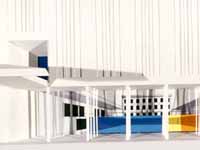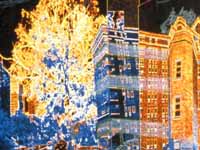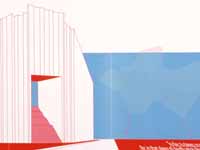click
here to get to the charrette's resource website
The 7th Annual University Charrette
The following text was presented
by the jury members at the vernissage of the Charrette exhibition on Monday,
October 29, 2001.
The prizes and the jury's comments
Two First Prizes ex aequo, and
a special mention
 |
«Après moi le déluge
- Public space heals the hospital» (Projet 20)
This project contains a detailed program for the public use of the entire
site including Cabot Square and elegantly details a project for a new entrance
way. Tupper street would be closed to traffic. Schematic plans, sections
and elevations show how to physically relate the square directly to the
different buildings and spaces on the block. We are told that «nature
breaks its way through the building at different levels and thus opens the
public to its new function as a centre for sports and preventative medicine.»
The jury greatly appreciated the detailed architectural expression of this
public doorway presented in the form of a low relief, giving a fair idea
of how it would function at two levels and its eventual impact on the vertical
scale of the Tupper street facade.
|
 |
«Multiplicité d'entrée»
(Projet 27)
This project works on the idea of the hospital complex as a small city.
The formal logic of individual pavilions set into smaller scale urban space
is developed as a way of using incremental interventions over time to progressively
transform these magnificently tall and complex structures. This idea has
the effect of giving to people using the urban promenade installed between
buildings the full impact of the complex monumentality of these structures.
|
 |
Une Mention Spéciale
du Jury
«EXIT» (projet 21) The jury appreciated
this original approach to the problem of the reuse of these buildings. «The
gift of life through recycling» as the project puts its idea means
that those that in the future will no longer want to live in this over populated
land could choose to die and to recycle their body parts. It's the analogy
of recycling the buildings by the instauration of a new body recycling medical
facility. This project was judged to be the best of the group of entries
that had worked mainly on the idea of new use.
|
The jury's comments
1. The theme of this charrette
was; « Post-modern Pathologies: Decommissioning the 20th-Century Hospital
».
2. The objectives of the charrette:
Students were asked to propose a reuse scenario for the Montreal Children's
Hospital, and to express the vocation of the hospital's new use or uses in
the form of a new public entry. Students were asked to consider the institution's
history and the building's immediate urban context in their proposals.
The jury:
Members:
Jo-Anne BALCAEN artiste, program coordinator at Articule, the artist run center
Julie SAINT-ARNAUD landscape architect
Sylvie GIRARD architect
Louis BRILLANT architect
Secretary: Alan KNIGHT, Associate
professor, School of Architecture, Faculté de l'Aménagement
de l'Université de Montréal
Observer: Nancy DUNTON, Head of University and Professional Programs at the
C.C.A.
General remarks from the jury:
The jury appreciated the excellent
participation of students in this year's 7th edition of the CCA charrette.
The jury judged 31 projects, with two more submitted but disqualified for
non conformity with the charrette rules, developed by 33 teams of designers
coming from 5 different universities associated with the discipline of environmental
design.
The jury noted from the start that
the challenge of the themes associated with this year's project had resulted
in only around 10% of the submitted projects dealing directly with questions
of built form and entranceways. The teams were asked to deal with the complexities
of programmatic considerations recycling an architectural ensemble of 20th
century hospital pavilions built at different epochs, at the same time as
they were to look at the urban context of the Cabot Square and the entire
Children's hospital block. Finally, the charrette program asked them to explore
questions of space and volume, of circulation and orientation, of materials
and structure, implicit in the project for a new entranceway into this magnificent
collection of buildings.
Five projects addressed themselves
to the idea of nature and its healing properties, in a re-working of the perennial
dichotomy of Nature versus Culture. These projects were not given prizes as
they tended to miss the central interest of the project in the environmental
qualities of the site both in terms of the existing green open spaces and
the architectural culture of the buildings. They did however provide the jury
with an interesting debate on a series of questions, - how to de-construct
the buildings, - how to manage the ruins of this ensemble and generally how
to re-appropriate such buildings in a less densely populated city.
Other projects interpreted the
building and its urban environment within overtly medical metaphors - healing,
prevention (and not cure) of health problems, building for life, death, resuscitation,
and pathology. One such project was accorded a special mention by the jury.
Some projects limited their critical discourse to readings and statements
exclusively concerned with the future vocation of the existing buildings,
without attacking the problem of architectural form, either of the buildings
or of an entranceway. Others were content to provide a commentary on the subject
of this year's charrette problem.
Yet other projects reflected on
the programmatic problem of whether to create a mega-block, giving the ensemble
one major function, or if one should keep the essential character of an urban
block made out of separate building pavilions with separate functions and
to use the interstitial spaces as smaller scale urban space. These teams saw
the hospital complex as a small town, or a city neighbourhood possessing interesting
urban characteristics that could be called into play in their projects. These
last two approaches characterized the prize-winning projects chosen by the
jury for their over-all excellence.
A further note from the secretary of the jury
The jury debated extensively the
different issues raised by the projects. Their deliberations were conducted
with method and were extremely detailed and rich. All decisions concerning
the attribution of specific prizes were unanimous.
and now to the EXPO
in an orderly manner


